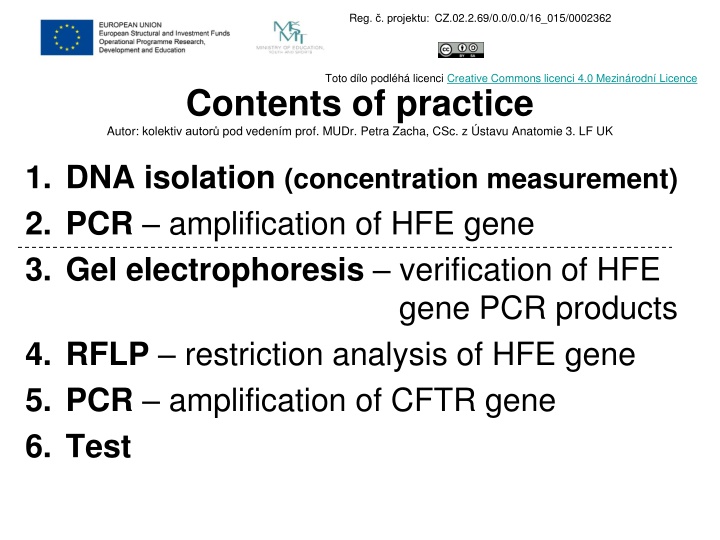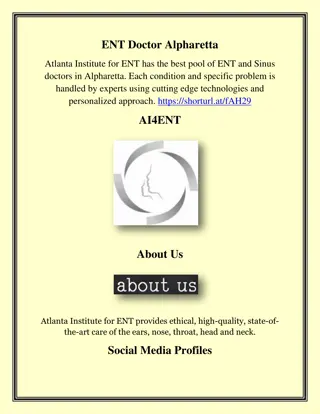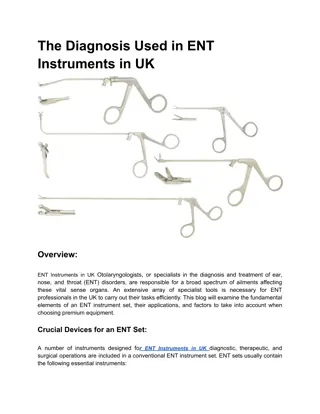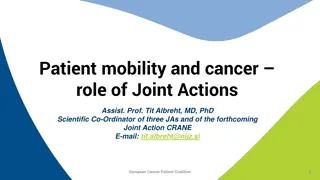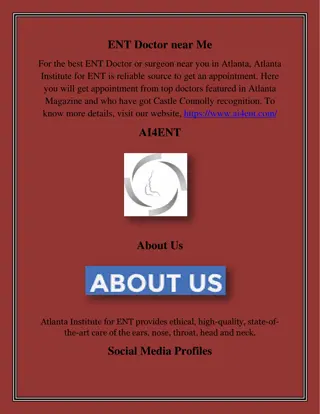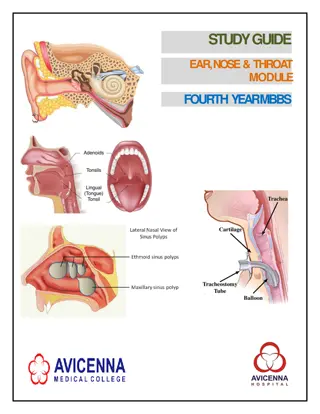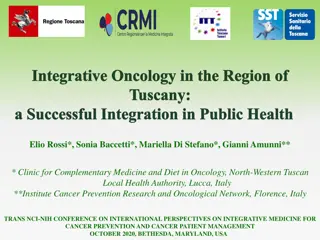ENT Update: Voice, Swallowing, and Cancer Awareness
This presentation by Gerard Kelly, an ENT surgeon, provides insights on common ENT conditions, symptoms in throat disorders, examination techniques, red flag symptoms, and treatment approaches for head and neck cancer. It covers a wide range of topics related to ear, nose, and throat health, emphasizing the importance of early detection and management.
Download Presentation

Please find below an Image/Link to download the presentation.
The content on the website is provided AS IS for your information and personal use only. It may not be sold, licensed, or shared on other websites without obtaining consent from the author.If you encounter any issues during the download, it is possible that the publisher has removed the file from their server.
You are allowed to download the files provided on this website for personal or commercial use, subject to the condition that they are used lawfully. All files are the property of their respective owners.
The content on the website is provided AS IS for your information and personal use only. It may not be sold, licensed, or shared on other websites without obtaining consent from the author.
E N D
Presentation Transcript
Reg. . projektu: CZ.02.2.69/0.0/0.0/16_015/0002362 Toto d lo podl h licenci Creative Commons licenci 4.0 Mezin rodn Licence Contents of practice Autor: kolektiv autor pod veden m prof. MUDr. Petra Zacha, CSc. z stavu Anatomie 3. LF UK 1. DNA isolation (concentration measurement) 2. PCR amplification of HFE gene 3. Gel electrophoresis verification of HFE gene PCR products 4. RFLP restriction analysis of HFE gene 5. PCR amplification of CFTR gene 6. Test
Tested mutations (the most frequent/severe) Cystic fibrosis: CFTR gene, chromosome 7 F508 mutation Hereditary hemochromatosis: HFE gene, chromosome 6 C282Y + H63D mutations
CFTR gene: delta F508 mutation = deletion of phenylalanine (508thAA in protein chain) Normal DNA DNA 5 AAT ATC ATC TTT GGT GTT 3 Protein Asn Ile Ile Position 505 506 507 508 509 510 Phe Gly Val Mutated DNA DNA 5 AAT ATC AT - - - T GGT GTT 3 5 AAT ATC ATT Asn 505 506 507 - - GGT GTT 3 - Gly Val 509 510 DNA Protein Position Ile Ile
HFE gene: C282Y mutation = substitution of cysteine by tyrosine (282ndAA in protein chain) Normal DNA 5 ...... TGC .. 3 C Cys Cysteine (TGC) at position 282 of protein chain Mutated DNA 5 ...... TAC .. 3 Y Tyr Tyrosine (TAC) at position 282 of protein chain
HFE gene: H63D mutation = substitution of histidine by asp. acid (63rdAA in protein chain) Normal DNA 5 ......CAT 3 H His Histidine (CAT) at position 63 of protein chain Mutated DNA 5 ......GAT .. 3 D Asp Aspartic acid (GAT) at position 63 of protein chain
DNA isolation Basic steps: 1) Releasing of DNA into the solution = Cell lysis 2) Protein removal 3) Impurities removal 4) Measurement of DNA concentration (spectrophotometry, absorbance at 260 nm)
PCR (polymerase chain reaction) Amplification of target DNA part in 30 40 cycles Each cycle consist of: Denaturation Annealing Extension Basic components of PCR: DNA sample Pair of primers (Forward + Reverse) Free nucleotides (dATP, dTTP, dCTP, dGTP) DNA polymerase
Basic types of PCR General PCR target + complete analysis subsequent analysis of PCR product is needed Allele specific PCR target analysis
HFE gene: mutation C282Y PCR MIX per 1 sample (yellow tube): H2O buffer Mg2+ dNTP mix 0.5 l Primer 1 Primer 2 DNA 15.0 l 2.5 l 2.0 l 1.5 l (PC1) 1.5 l (PC2) 1.8 l Taq polymerase 0.2 l (on ice)
HFE gene: mutation H63D PCR MIX per 1 sample (blue tube) H2O buffer Mg2+ dNTP mix 0.5 l Primer 1 Primer 2 DNA 14.5 l 2.5 l 2.5 l 1.5 l (PH1) 1.5 l (PH2) 1.8 l Taq polymerase 0.2 l (on ice)
Next step in analysis of mutation in hemochromatosis gene Subsequent analysis of PCR product
1) General PCR: Verification of PCR product using gel electrophoresis (mutation C282Y) Amplified DNA 390 bp 404 bp 331 bp
2) RFLP Restriction Fragment Length Polymorphism: Restriction analysis of DNA by its digestion with restriction endonucleases (RE) in specific restriction sites When the DNA sequence is different (polymorphism, mutation), it creates or disturbs a specific site for RE after restriction, fragments with different sizes are formed
Restriction fragment length polymorphism Restriction endonuclease (RE) about 2100 bacterial REs known RE recognizes variously short nucleotides sequences (4, 6, 8 ntds; usually palindromes), in which they digest covalent phosphodiester bonds Principle of the analysis DNA sample obtaining (genomic DNA, PCR product) DNA sample digestion with a restriction enzyme into fragments of different sizes DNA fragments separation by gel electrophoresis
Sequence of amplified DNA for C282Y mutation analysis Healthy sequence = no cleavage 5 - TGGCAAGGGTAAACAGATCC TGGCAAGGGTAAACAGATCCctctcctcatccttcctctttcctgtcaagtgccctcctttggtgaaggtgacacatcatgtgacctcttca gtgaccacactacggtgtcgggccttgaactactacccccagaacatcaccatgaagtggctgaaggataagcagccaatggatgccaaggagttcgaac G GTG GC Ccaggtgg A ctaaagacgtattgcccaatggggatgggacctaccagggctggataaccttggctGTAC GTACcccctggggaagagcagagatatacGT agcacccaggcctggatcagcccctcattgtgatctggggtatgtgactgatgagagccaggagctgagaaaatctattgggGGTTGAGAGGA GGTTGAGAGGAGTGC TGC CTGAG CTGAGgaggtaattatggcagtgagatgaggatctgctctttgttagggggtgggctgagggtggcaatcaaaggctttaacttgctttttctgttttagagccctca ccgtctggcaccctagtcattggagtcatcagtgga 3 Mutated sequence = cleavage 5 - GTAC - 3 TAC: 3 - CATG - 5 : restriction site for restriction endonuclease RsaI Mutation C282Y: GTGC GTAC (restriction site is created by mutation)
Evaluation of the results of the RFLP analysis Mutation C282Y (v bp) Healthy homozygote : Homozygote with mutation : 250 Heterozygote : 250 140 111 111 250 140
Sequence of amplified DNA for H63D mutation analysis Healthy sequence = cleavage 5 cagacacagctgatggtatgagttgatgcaggtgtgtggagcctcaacatcctgctcccctcctactacACATGGTTAAGGCCTGTTGCtct Gtctccaggttcacactctctgcactacctcttcatgggtgcctcagagcaggaccttggtctttccttgtttgaagctttgggctacgtggatgaccagctgttcgtgttc C G taTGATC AtgagagtcgccgtgtggagccccgaactccatgggtttccagtagAATTTCAAGCCAGATGTGGCtgcagctgagtcagagtctg aaagggtgggatcacatgttcactgttgacttctggactattatggaaaatcacaaccacagcaaggg 3 Mutated sequence = no cleavage 5 - TGATCA - 3 GTAC: 3 - ACTAGT - 5 : restriction site for restriction endonuclease BclI Mutation H63D: TGATCA TGATGA (restriction site is lost with mutation)
Evaluation of the results of the RFLP analysis Mutation H63D (v bp) Healthy homozygote: Homozygote with mutation: Heterozygote: 208 208 138 70 138 70
HFE GENE PCR PRODUCT ANALYSIS RFLP METHOD Detection of mutation in PCR product of HFE gene using Restriction Fragment Length Polymorphism analysis. Restriction mix per 1 sample Yellow tube (C282Y): Blue tube (H63D): water buffer Yellow PCR product 12.0 l 1.4 l 7.0 l water buffer Blue PCR product 12.0 l 1.4 l 7.0 l RE (RsaI) 0.7 l RE (BclI) 0.7 l RE: restriction endonucleasis
Detection of F508 mutation in CFTR gene Allele specific PCR: This technique depends on the specificity of PCR primers 3 primers are made: General primer (G) Specific primer to normal sequence (N) Specific primer to mutated sequence (M) TARGET SEQUENCE X G N M
PCR reaction is performed in 2 tubes: PCR mix M0 contains primer G and primer N PCR mix M1 contains primer G and primer M C/N 1 C/M 2 C/N 1 C/M 2 C/N 1 C/M 2 Homozygous No Mutation Heterozygous Carrier Homozygous for Mutation
Detection of F508 mutation in CFTR gene Patient 1 2 3 + + + DNA marker NC Mix M0 Control gene control of PCR process CFTR gene general primer + primer specific to sequence without mutation + - + Mix M1 Control gene control of PCR process CFTR gene general primer + primer specific to mutated sequence
Polymerase chain reaction (PCR) MUTATION F508 (CYSTIC FIBROSIS) PCR MIX per 1 sample PCR mix 1: PCR mix 0: water 8.5 l water 8.5 l buffer 2.0 l buffer 2.0 l dNTP mix 4.0 l dNTP mix 4.0 l Mg2+ 2.0 l Mg2+ 2.0 l primers M1 1.2 l primers M0 1.2 l DNA 2.0 l DNA 2.0 l Taq polymerase 0.4 l Taq polymerase 0.4 l (on ice) (on ice)
Hemochromatosis autosomal recessive disease affecting iron metabolism excessive iron absorption, its deposition in organs (mainly parenchymal) and subsequent damage of the organism hepatopathy (cirrhosis, hepatocellular carcinoma) diabetes mellitus, arthropathy, hypogonadism, kardiomyopathy, amenorhea serum iron, transferrin saturation, ferritin, liver biopsy repeated phlebotomy
http://www.rcsb.org/3d-view/1DE4/1 HFE-TFR2 interaction model H63 Signal seq. cleaved H63 = H41 C282 = C260 C282 HFE TFR
Cysticfibrosis the most common autosomal recessive (AR) disorder among Caucasians chronic and progressive disease median at death is ~ 35 years Organs Affected by CF Lung: thick accumulations of mucus, breathing difficulties, frequent resp. infectious, permanent lung damage Pancreas: exocrine pancreatic insufficiency malabsorption of proteins and fats Liver: plugging of small bile ducts, cirrhosis GIT: intestinal obstruction-Meconium ileus (15-20% CF babies) Reproduction: improper formation of Vas deferens sterility (95% CF male) Skin: CF patients have salt crystal formation on their skin (sweat excessively)
Molecular causationof CF mutations in the CFTR gene CFTR gene coding for chloride channel protein: cystic fibrosis transmembrane conductance regulator located on the plasma membrane of epithelial cells of the lungs, pancreas, sweat glands, and other tissues cAMP regulated chloride channel Cl- TM- transmembrane spanning domains lumen TM1 TM2 NBD1 NBD2 NBD-nucleotide binding domains (ATP) cytoplasm R R-regulation domain (cAMPdep.)
Mutation in the CFTRgene germinal mutations somatic mutations have not been described so far de novo mutation rarely distribution of mutation shown population specificity
